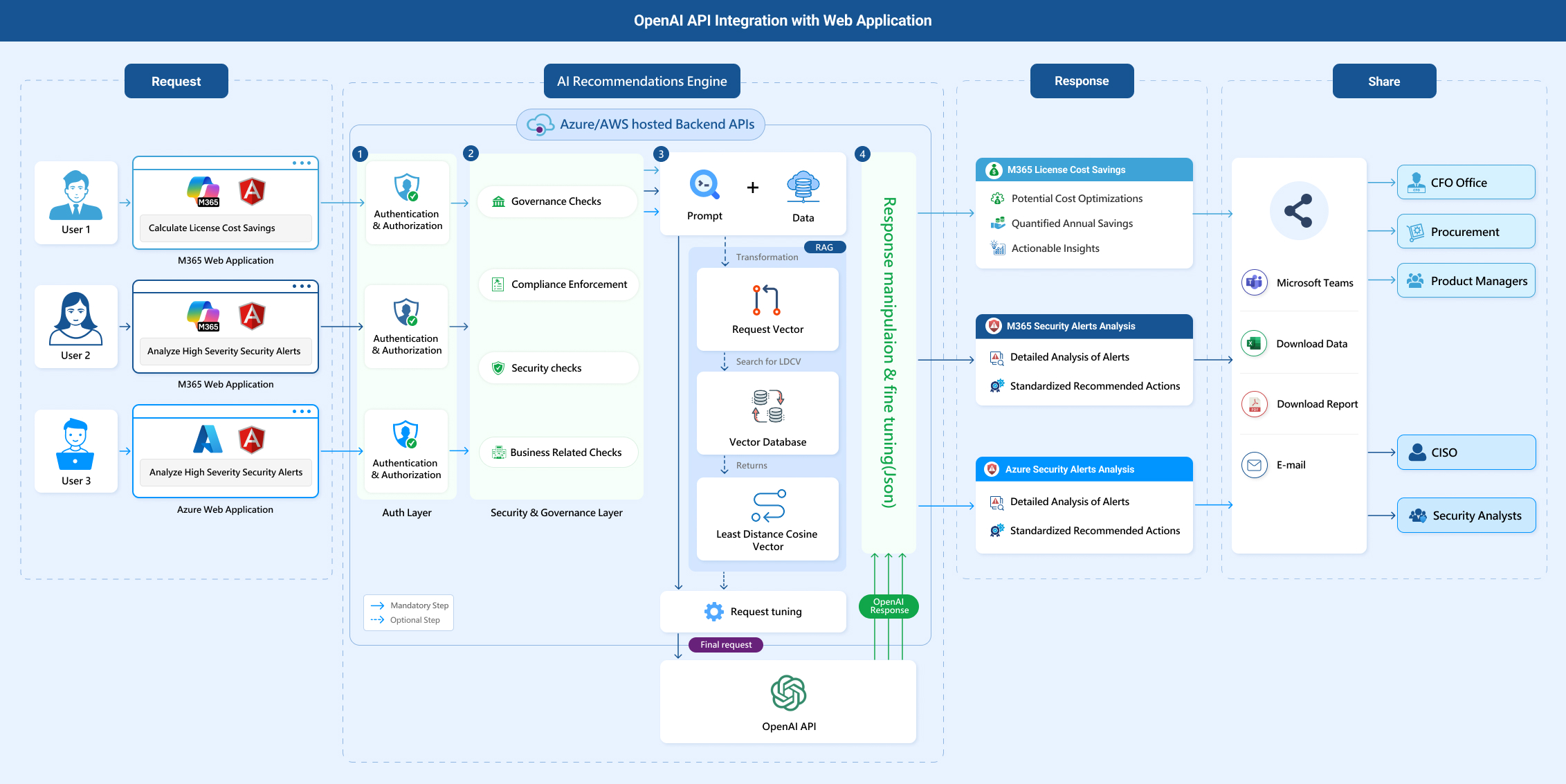
Empowering Business Applications with OpenAI API Integration
In today’s technology-driven world, integrating artificial intelligence (AI) into web applications is no longer a luxury—it’s essential for operational excellence and strategic advantage. At the forefront of this transformation is the OpenAI API, a powerful tool that enables businesses to make smarter, faster decisions while streamlining operations and enhancing security.
This blog explores a real-world architectural approach for integrating the OpenAI API into web applications, detailing each phase of the integration journey and the business benefits organizations can expect.
Architectural Overview of OpenAI API Integration
A successful AI integration involves meticulous planning and precise execution. Here’s a detailed breakdown of a robust, structured approach based on our recent integration case study. Read the case study here.
Phase 1: User Requests via Web Applications
The integration begins at the frontend, built with modern Angular technology, enabling users to seamlessly request actionable insights across multiple scenarios:
- Microsoft 365 Web Application:
- User 1: Requests calculation of potential license cost savings.
- User 2: Requests detailed analysis and remediation of high-severity security alerts within their Microsoft 365 environment.
- Azure Web Application:
- User 3: Seeks analysis and standardized recommendations for addressing high-severity security alerts in Azure environments.
Business Benefit:
- Intuitive user interface promoting widespread adoption.
- Clear categorization of requests enhancing operational efficiency.
Phase 2: AI Recommendations Engine
Once requests are captured, they’re passed to the AI Recommendations Engine, comprising several sophisticated components designed to optimize accuracy and relevance:
- Prompt Generation:
- The system dynamically generates context-rich prompts, incorporating user requests and corresponding data.
- Request Vector Transformation:
- Each prompt is converted into a structured request vector, optimizing it for retrieval and matching processes.
- Vector Database Query:
- A Vector Database is queried to identify relevant historical data points using Least Distance Cosine Vector (LDCV) matching, ensuring accuracy in recommendations.
- Least Distance Cosine Vector (LDCV) Analysis:
- The closest matching data points are selected based on similarity metrics, ensuring tailored, contextually precise insights.
- LLM API (Large Language Model API):
- Constructs robust API requests that leverage the analysis from previous steps to ensure accuracy and relevance.
Business Benefit:
- Maximizes accuracy and relevancy through sophisticated AI-driven data analysis.
- Automates complex data handling, reducing manual overhead.
Phase 3: Integration with OpenAI API
The system’s core strength lies in leveraging the OpenAI API, a powerful generative AI engine, to produce precise, insightful recommendations:
- Real-Time Insight Generation:
- The OpenAI API processes structured prompts and produces immediate, accurate analysis on cost optimizations and security vulnerabilities.
- Scalability and Reliability:
- Offers scalable performance to handle extensive organizational data volumes and complexity.
Business Benefit:
- Provides quick, highly accurate, AI-powered decision support.
- Significantly reduces response times from data analysis to actionable insight.
Phase 4: Insightful Response Delivery
Results generated by the OpenAI API are presented back to users in clear, actionable formats:
- Microsoft 365 License Cost Savings:
- Precise insights into potential cost optimizations and quantified annual savings.
- Microsoft 365 Security Alerts Analysis:
- In-depth analysis of threats, along with standardized, easily executable remediation actions.
- Azure Security Alerts Analysis:
- Detailed vulnerability assessments with standardized recommendations, facilitating quick and effective responses.
Business Benefit:
- Enhances visibility into critical areas like licensing costs and cybersecurity.
- Simplifies decision-making processes by offering structured, actionable insights.
Phase 5: Seamless Sharing and Collaboration
The insights generated by AI can be effortlessly shared with key stakeholders using integrated collaboration tools, including:
- Microsoft Teams: Instant sharing within teams for faster collaborative decision-making.
- Excel Downloads: Structured data reports and analyses for further review and record-keeping.
- Automated Email Reporting: Direct email distribution to critical stakeholders.
Key recipients include:
- CFO Office, Procurement, Product Managers: For licensing cost management.
- CISO, Security Analysts: For security threat mitigation and response management.
Business Benefit:
- Promotes effective collaboration and ensures key stakeholders stay informed and aligned.
- Accelerates organizational response times through streamlined communication.
- Helps in standardizing response for high severity security alerts.
Strategic Business Benefits of OpenAI API Integration
Organizations investing in integrating OpenAI’s API within their web applications can achieve:
- Cost Optimization:
- AI-driven analytics identify tangible cost-saving opportunities, directly improving profitability.
- Enhanced Cybersecurity:
- AI rapidly identifies and recommends responses to critical threats, minimizing risk and potential costs associated with security breaches.
- Operational Efficiency:
- Automating complex analytics tasks frees up valuable human resources for strategic activities, significantly enhancing organizational productivity.
- Scalable Infrastructure:
- Designed for flexibility, the AI-driven approach can easily scale to support growing business demands.
- Competitive Advantage:
- Companies utilizing advanced AI analytics outperform competitors by making faster, more informed decisions.
Conclusion: Empower Your Business with AI-Driven Applications
Integrating OpenAI API within web applications positions businesses at the forefront of innovation, combining efficiency, cost reduction, and security enhancement into a cohesive strategic advantage. Organizations choosing this path gain immediate operational benefits and long-term competitive positioning, driving sustained growth and agility.
At Loves Cloud, we specialize in seamlessly integrating AI technologies into your business applications, delivering tangible, impactful results. Ready to explore how AI integration can transform your business?
Contact us today at biz@loves.cloud to start your AI integration journey and experience the future of intelligent business solutions.

